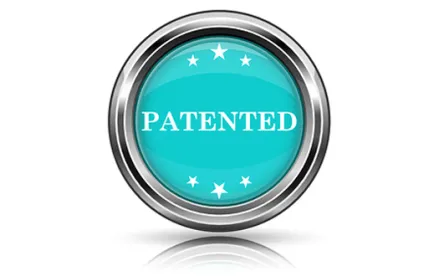In its Final Written Decision, the Board found that Petitioner had not proven that the challenged claims of the ‘167 patent are unpatentable as obvious. The ‘167 patent discloses “edible water-soluble delivery systems in the form of a film composition including a water-soluble polymer, an active component selected from cosmetic agents, pharmaceutical agents, vitamins, bioactive agents and combinations thereof, and at least one anti-tacking agent.”
The Board first addressed claim construction under the broadest reasonable interpretation. The Board concluded that “the claims encompass a film having a structure which would result from a controlled drying process which forms a viscoelastic matrix within a few minutes of the drying process to lock-in the active component within the matrix, the film having a substantially uniform distribution of the active component, as measured by substantially equally sized individual unit doses which do not vary by more than 10% of the desired amount of the active component.”
The Board then turned to the obviousness challenge based on Chen and Tapolski. Chen discloses a “dosage unit comprising a water-soluble hydrocolloid and a mucosal surface-coat-forming film, such film including an effective dose of active agent.” Tapolsky discloses a device “for application of a pharmaceutical to mucosal surfaces” that “comprises an adhesive layer and a nonadhesive backing layer, and the pharmaceutical may be provided in either or both layers.”
Petitioner “contends that Chen describes multi-layer active component-containing films that have all of the ingredients and functional properties required by the challenged claims” but that “Chen’s disclosure of the application of a controlled drying process to a multi-layer film is limited.” Patent Owner “contends that Petitioner, for a number of reasons, has not shown that Chen’s film compositions include an active component distributed substantially uniformly throughout the film in the manner required by claim 17 and 110.”
As an initial matter, the Board addressed Petitioner’s argument that collateral estoppel applies. “[U]nder the doctrine of collateral estoppel, also known as issue preclusion, a judgment on the merits in a first proceeding precludes relitigation in a second proceeding ‘of issues actually litigated and determined in the first [proceeding].’” In re Freeman, 30 F.3d 1459, 1465 (Fed. Cir. 1994). It is within the Board’s discretion to decide whether a particular case is appropriate for application of the doctrine, however. Here:
We find that the instant inter partes review under the AIA offers a significant procedural opportunity to the parties that was not available in the prior inter partes reexamination proceeding of the ’588 patent cited by Petitioner. Specifically, inter partes reexamination proceedings are conducted essentially by the same procedure as routine examination of patent applications. 37 C.F.R. § 1.937(b). Although normal examination procedure allows for submission of evidence in affidavit form (37 C.F.R. §§ 1.131, 1.132), the rules for inter partes reexaminations do not provide for cross-examination of those affiants. See 37 C.F.R. §§ 1.902-1.997.
Moreover, “the testimony on cross-examination of one of Petitioner’s witnesses uncovered facts significant to our evaluation of the disclosure of the Chen reference, resulting in a determination on that issue different from the prior ’588 reexamination appeal decision cited by Petitioner.” Finally, the Board also noted that the time for appeal of the prior decision has not yet expired, thus the decision “is not final, and collateral estoppel is not applicable.” See Vardon Golf Co., Inc. v. Karsten Mfg. Corp., 294 F.3d 1330, 1333-35 (Fed. Cir. 2002).
Regarding the challenge, “Petitioner does not persuade us that a preponderance of the evidence supports its contention that Chen inherently describes films meeting the substantial uniformity of active component distribution required by claims 17 and 110 of the ’167 patent, based only on the visual appearance of the films.”
“Petitioner also does not persuade us that the disclosure in Example 1 of Chen . . . inherently meets the substantially uniform distribution of active component recited in claims 17 and 110 of the ’167 patent.” “Consistent dosage unit weight is not the uniformity standard recited in claims 17 and 110 of the ’167 patent”; “[r]ather, claims 17 and 110 expressly require a determination of the amount of active component.” Moreover, the Board credited Patent Owner’s declaration, which Petitioner did not dispute in relevant part.
Finally:
Neither Petitioner nor Dr. Cohen, however, directs us to a clear or specific teaching in Modern Coating that the measure of “uniformity” described therein (Ex. 1009, 268) is the same measure as that required by claims 17 and 110 of the ’167 patent, that is, a distribution of active component that varies by less than 10% between substantially equal size dosage units, as opposed to merely a uniform thickness. Moreover, neither Petitioner nor Dr. Cohen directs us to any clear or specific teaching in Modern Coating demonstrating that the films discussed therein actually satisfy the uniformity requirement of claims 17 and 110. Nor does Petitioner direct us to specific evidence, such as experimental test results, showing that any of the drying processes described in Modern Coating necessarily produce a film meeting the uniformity requirement of claims 17 and 110.
Thus, Petitioner “has not explained with adequate specificity how or why an ordinary artisan would have reasonably expected to be able to obtain a film having the required uniform active agent distribution.”



 />i
/>i

